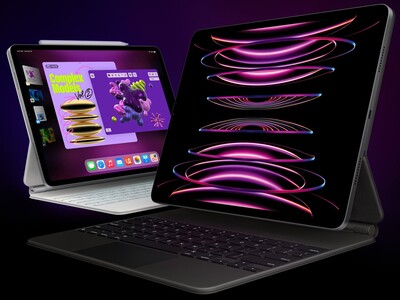- Kicsit extrémre sikerült a Hyte belépője a készre szerelt vízhűtések világába
- Egészen nagy teljesítményspektrumon fedné le a mobil piacot az AMD
- Kihívás a középkategóriában: teszten a Radeon RX 7600 XT
- Már a Sparkle is jegyezhet fehérbe öltöztetett videokártyákat
- Modern monitorokra köthető 3dfx Voodoo kártya a fészerből
- Dell notebook topic
- Hobby elektronika
- HiFi műszaki szemmel - sztereó hangrendszerek
- RAM topik
- Modern monitorokra köthető 3dfx Voodoo kártya a fészerből
- ASUS ROG Ally
- Kihívás a középkategóriában: teszten a Radeon RX 7600 XT
- NVIDIA GeForce RTX 3080 / 3090 / Ti (GA102)
- Vezetékes FEJhallgatók
- Kicsit extrémre sikerült a Hyte belépője a készre szerelt vízhűtések világába
Hirdetés
-


Toyota Corolla Touring Sport 2.0 teszt és az autóipar
lo Némi autóipari kitekintés után egy középkategóriás autót mutatok be, ami az észszerűség műhelyében készül.
-


Az Apple iPadOS-t is megrendszabályozza az EU
it Az EB közölte: az Apple iPad táblagépekre írt iPadOS rendszere is kapuőrnek számít, az üzleti felhasználókra gyakorolt fontossága miatt.
-


Samsung Univerzum: Az S23-at is megbabonázta a Galaxy AI
ma Rengeteg Samsung megkapja az AI alapú nyelvi, képi és keresőfunkciókat.
Új hozzászólás Aktív témák
-

Abu85
HÁZIGAZDA
Részlet az NV live chatből (GTC 2010):
Kérdés: We all know that Intel and AMD are looking at merging CPU cores and GPUs on the same die.
In my mind, the future is for hybrid computing, where different kind of processors working together and find their own kind of tasks to work on. Currently, multi-core CPU and many-core GPU are working together, tasks are distributed by software schedulers. Data parallel tasks are assigned to GPUs and task-parallel jobs are assigned to GPUs. However, communication between these two kinds of processors is the performance bottleneck. I hope NVIDIA can provide a solution on their desktop GPU product line too.Bill Dally:
That's exactly right. The future is heterogeneous computing in which we use CPUs (which are optimized for single-thread performance) for the latency sensitive portions of jobs, and GPUs (which are optimized for throughput per unit energy and cost) for the parallel portions of jobs. The GPUs can handle both the data parallel and the task parallel portions of jobs better than CPUs because they are more efficient. The CPUs are only needed for the latency sensitive portions of jobs - the serial portions and critical sections.---
Kérdés: Do you believe a time will come when GPU and CPU are on the same chip or "board" it seems the logical next step to avoid the huge PCI-E latency and have a better GPU-CPU interactivity ? i know there is ongoing research in this area already ...but what is your personal opinion on the possibility and benefits of this ?"
Bill Dally:
Our Tegra processors already combine CPUs and a GPU on a single chip. For interactivity what's important is not the integration but rather having a shared memory space and low latency synchronization between the two types of cores.
I don't see convergence between latency-optimized cores and throughput optimized cores. The techniques used to optimize for latency and throughput are very different and in conflict. We will ultimately have a single chip with many (thousands) of throughput cores and a few latency-optimized cores so we can handle both types of code.A codemorphing sok erőforrást emészt fel. A GPU erejének a felét elviszi egy processzormag emulálása. Sokkal olcsóbb két ARM, nem mellékesen sokkal hatékonyabb is. Ha annyira jó lenne az emulálás, akkor már rég emulálna mindenki, a gond az, hogy nagyon nem jó emulálni.
[ Szerkesztve ]
Senki sem dől be a hivatalos szóvivőnek, de mindenki hisz egy meg nem nevezett forrásnak.
-

Abu85
HÁZIGAZDA
Levezetnéd, hogy konkrétan, hogy gondolod az emulálást egy GPU-n. Mennyi erőforrást szánsz rá?
A codemorphing hatalmas bukta volt annak idején. És akkor egy erre optimalizált magról volt szó, vagyis a technikához szabták a hardvert. A GPU-nál erre nagyon nincs lehetőség, mert az a teljesítmény rovására menne. Technikailag (szigorúan elméletben) el tudom képzelni, hogy a codemorphingra szabják a rendszert, de gyakorlatban azért ott van egy fontos tényező, hogy gyorsabbnak kell lenni a Ferminél. Ez egy komoly akadálya a codemorphing előtt, márpedig a tranzisztorszám limitált.[ Szerkesztve ]
Senki sem dől be a hivatalos szóvivőnek, de mindenki hisz egy meg nem nevezett forrásnak.
Új hozzászólás Aktív témák
ph Már nem az Egyesült Államoké a világ leggyorsabb szuperszámítógépe.
- ASUS ROG STRIX Z370-H GAMING + Intel Core i5-8600K + SK Hynix 16GB DDR4 2666MHz - Számla + Garancia
- VADIÚJ, BONTATLAN! Mac Mini M2 8GB 256GB
- i7 7700K////1070 TI///16GB
- Intel NUC5CPYH (Celeron N3050, N3060, J3060) - 4GB RAM, 120GB SSD
- Eladó! ASRock H110M-ITX/AC + Intel I5 7500 (csomagküldés az árban)











